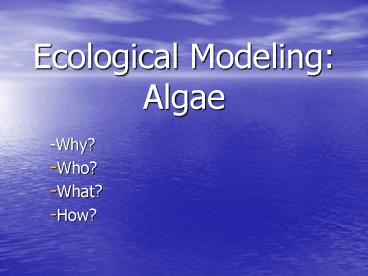Ecological Modeling: Algae - PowerPoint PPT Presentation
1 / 31
Title:
Ecological Modeling: Algae
Description:
Ecological Modeling: Algae-Why? Who? What? How? Who? What? Examples of Models with Algal Modeling Included CIAO- Coupled Ice Atmosphere Ocean Model ERSEM- European ... – PowerPoint PPT presentation
Number of Views:106
Avg rating:3.0/5.0
Title: Ecological Modeling: Algae
1
Ecological Modeling Algae
- -Why?
- Who?
- What?
- How?
2
- Who?
3
- What?
4
Examples of Models with Algal Modeling Included
- CIAO- Coupled Ice Atmosphere Ocean Model
- ERSEM- European Regional Seas Ecosystem Model
- CE QUAL
- DSSAMt
- HSPF
- WASP
- Aquatox
- Ecosim
- FFFMSIPaAG,
- Johns Model,
- Dons model
- ..Yada, Yada, Yada,
5
What is typically modeled?- Phytoplankton-
Periphyton
6
Pennate Diatoms
7
Centric Diatoms
8
Filamentous Green Algae
9
Chrysophyte
10
Cryptophyte
11
Dinoflagellates
12
Filamentous Cyanobacteria
13
Coccoid Cyanobacteria
14
Red Algae
15
Brown Algae
16
The point is that is. it is a Diverse Group
- Size (pico, nano,micro)
- Physiologically
- Biochemically
- Life Histories
- And Therefore, Ecosystem Function!!
17
The How Algal Population Growth Formula
dA/dt mmax(T)AMIN(NLIM) LightLIM -
grazing /- advection/dispersion /-
settling
Be a bit skeptical ask can the equations capture
algal physiologies and community dynamics that
you are after?
18
uMax
- Usually set by Temperature
- Eppley 1972 (most common)
- Other approaches
- species-genera specific temperature relationships
- Multiple Topt, Tmax Tmin, fxns
19
Nutrient Limitation
- Monod kinetics
- Usually applied as the single most limiting
nutrient (Leibigs Law of The Minimum
improperly invoked). - Half saturation coefficients (ks) and nutrient
concentrations are all that are needed.
m mmax(N/(KsN)
20
Challenges
- How to set the Ks.
- What nutrient concentration to use bulk or
microscale?
Half Saturation Constants
Figure 2. Predictions from biofilm theory using
hypothetical model parameters.
21
Light
- Photosynthesis versus Irradiance Curves (PE
curves) - Ek is needed.
- Challenges
- How to calculate effective E.
- How to set Ek (remember.. plants/algae
physiologically adapt).
Pmax
Ek
22
- Effective E
- Typically Calculated by 1st order attenuation
accounting for water constituents - Ed or Eod, or Eo?
- PAR, PUR, or PHAR?
23
- Integrate over depth and time for applicable Dt.
WASP 6 manual
24
Note
- dA/dt mmax(T)AMIN(NLIM) LightLIM
- This is net primary production
- Also, this is the net cellular growth rate
- Equation readily allows addition of other
environmental constraints such as salinity, pH,
etc.
25
Grazing
- Zero Order loss term/Constant
- First order loss term
- Kinetics based on constant grazer
biomass/abundance but accounts for monod kinetics - Kinetics with grazer abundance predicted as well
(Lotkka-Volterra, NPZ models)
26
Other losses.
- Settling?
- Mortality-
- Viral, fungal, Ecotox pollutants (e.g.
phototoxins, LD50s) other..? - Drift/scour (fxn velocity and biomass)
27
- Algal Algorithms embedded in spatial models
28
Still Not Very Satisfying....
- Uncertainties in Temperature and mmax
- can lead to large variations in accumulation
rates and biomass.. (exponentially compounding
uncertainty) - Treatment of Kss and Eks as constants
- Transient luxury uptake of nutrients rarely
accounted for (e.g. Carbon storage and growth at
night, i.e. unbalanced growth). - Minimal Constraints on loss terms
- Stability issues
29
Other Approaches
- More Empirical Relationships
- e.g. TP vs. Chlorophyll a
- Quantum Yield Approach
- EoA? Primary Production
30
Free stuff
- I (Heather/Laurel) will post Stella models
- http//www.hps-inc.com/
- Download isee Player (its free)
31
Background Readings
- Eppley 1972
- Chapra pages 603-615
- Brush et al. 2002
- Chapra 742-747 (Solar Radiation and light
extinction sections) - WASP Manual
- Kirk Light and Photosynthesis in the sea
- Sverdrup Conditions for phytoplankton blooms































